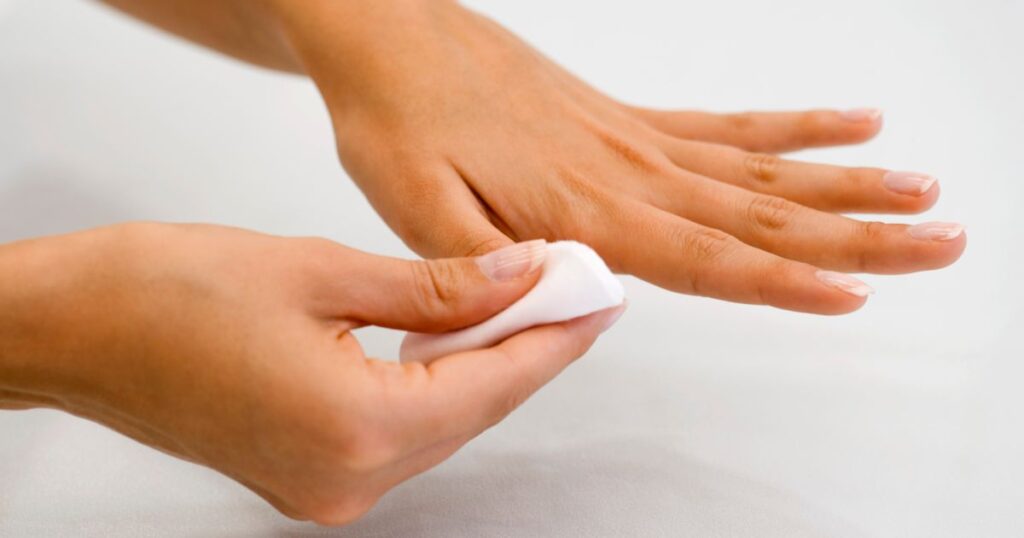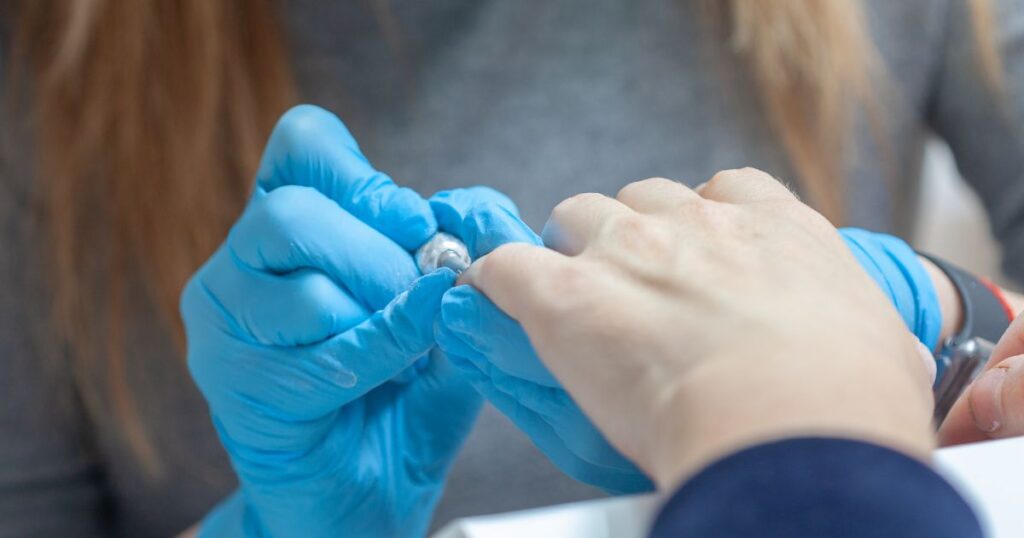Acetoneis a common ingredient in nail polish removers. Its power to quickly break down and remove nail polish makes it a staple in nail salons around the world. But as we dive deeper into the era of clean beauty, which champions safer, more eco-friendly beauty solutions, questions arise about traditional ingredients like acetone.
In this article, we will unpack everything acetone – from what it actually is to its pivotal role in the beauty world. We’ll also guide you through the process of removing shellac nail polish at home without acetone, aligning with the clean beauty movement’s push for healthier alternatives.
Here’s what you’ll discover:
- The essence of acetone and why it’s a staple in nail polish removal.
- The balancing act between acetone’s efficiency and the clean beauty movement’s safety standards.
- Step-by-step guidance on removing shellac nail polish at home, sans acetone.
- A glimpse into the future: how innovation might shift our reliance on acetone towards more sustainable beauty practices.
Table of Contents - Click to Go
What is Acetone?
Pure acetone is a powerful and widely used solvent in the beauty industry, particularly in products designed for nail care. To understand its popularity and scrutinize its safety, let’s break down its characteristics and address common misconceptions:
- Chemical Composition and Properties:
- Acetone, or propanone, is the simplest form of dimethyl ketone.
- It’s a colorless liquid, highly volatile, and flammable.
- Known for its strong, sweetish odor.
- Dissolves in water, making it highly versatile.
- Widespread Use in Cosmetics:
- Primarily found in nail polish removers.
- Pure acetone is used in professional salons for removing acrylic nails and gel manicures.
- Clean Beauty Considerations:
- Its efficacy is unmatched, yet it raises concerns over dryness and irritation.
- Clean beauty advocates seek products that balance effectiveness with gentleness.
- Common Misconceptions:
- Toxicity: While acetone is potent, it’s not classified as a carcinogen.
- Health Risks: In controlled, moderate use, acetone poses minimal health risks. Problems arise from overexposure or ingestion, not occasional contact.
- Environmental Impact: Acetone is biodegradable, but its production and disposal must be handled responsibly.
Understanding acetone’s role in cosmetics, especially nail care, requires balancing its effectiveness with its potential for irritation and dryness. This knowledge empowers consumers to make informed decisions about their beauty products, aligning with the clean beauty movement’s values.
What is Acetone Used For?

Acetone’s role in beauty extends beyond its basic chemical properties, serving as a cornerstone for various products. Its primary use, especially in nail care, is as nail polish remover.
Here’s a closer look at how acetone is utilized in the beauty industry:
- Nail Polish Removal:
- Efficiency: Easily dissolves nail polish, including durable formulas like gel and shellac.
- Versatility: Works on various types of nail enhancements, such as acrylics and dip powders.
- Cleaning Beauty Tools:
- Pure acetone is used by professionals to clean tools and surfaces, ensuring a sterile environment.
- Preparation for Nail Services:
- Cleans the nail surface before applying polish or enhancements, promoting better adhesion.
In the context of clean beauty, the conversation around acetone navigates the line between its effectiveness and the desire for safer, less harsh ingredients. Clean beauty brands are challenged to find a balance, leading to the development of products that maintain high performance while being mindful of health and environmental concerns.
- Balancing Act in Clean Beauty:
- Effectiveness vs. Safety: The goal is to retain acetone’s benefits without compromising on gentleness.
- Innovative Formulations: Clean beauty brands explore formulations that minimize potential irritation and dryness associated with acetone use.
Clean Beauty Alternatives to Acetone

The clean beauty movement has ushered in a wave of innovation, especially in nail care, where the demand for non toxic substances and alternatives to acetone is rising. These alternatives promise effective nail polish removal without the harshness of traditional solvents. Let’s explore the ingredients and benefits of these cleaner options:
- Key Ingredients in Acetone-Free Removers:
- Ethyl Acetate & Isopropyl Alcohol: Less aggressive solvents that are effective yet milder on the nails and skin, but we prefer the next two options.
- Essential Oils: Ingredients like lavender or eucalyptus oil add soothing properties and pleasant scents.
- Vitamin E and Aloe Vera: Offer nourishing benefits, counteracting the dryness typically associated with nail polish removal.
- Effectiveness and Considerations:
- While acetone-free removers are gentler, they may require more time and product to remove certain types of nail polish, especially shellac and gel formulas.
- The balance each product strikes between efficacy and gentleness varies, making some better suited for specific needs or preferences.
Choosing and Using Acetone-Free Alternatives:
- Research Brands: Look for clean beauty endorsements and certifications.
- Read Reviews: See how others have experienced their effectiveness, especially with stubborn polish types.
- Consider Your Nail Health: If you have brittle or damaged nails, acetone-free options can be particularly beneficial.
Popular Clean Beauty Brands:
- Brands like Ella+Mila, Karma Organic, and Tenoverten have been praised for their effective, acetone-free formulations that align with clean beauty standards.
Benefits of Switching:
- Reduced Chemical Exposure: Minimizes the risk of dryness, irritation, and long-term health concerns.
- Environmental Considerations: Many acetone-free removers are made with biodegradable ingredients and sustainable packaging.
- Nail Health: Promotes stronger, healthier nails over time.
The shift towards acetone-free nail polish removers reflects a broader trend in beauty towards safer, more sustainable practices. By embracing these alternatives, consumers can enjoy vibrant, polished nails without compromising their health or environmental values.
How to Take Nail Polish Shellac Off at Home WITHOUT Acetone

Removing shellac nail polish at home without using acetone is a gentle yet effective process that aligns with clean beauty standards. Here’s a step-by-step guide that utilizes acetone-free alternatives to maintain nail health and minimize chemical exposure.
Step-by-Step Guide to Removing Nail Polish Without Acetone
- Gather Your Materials:
- Acetone-free nail polish remover
- Cotton balls or pads
- Foil strips or reusable nail clips
- A nail file
- A wooden or rubber cuticle pusher
- Nourishing oil or cream for post-removal care
- Prep Your Nails:
- Lightly buff the shiny top coat of your shellac nails with a nail file. This helps the remover penetrate the polish.
- Apply the Remover:
- Soak a cotton ball or pad in the acetone-free remover.
- Place it directly on your nail.
- Secure it with a foil strip or a reusable nail clip.
- Repeat for each nail.
- Wait Patiently:
- Leave the soaked cotton balls or pads on your nails for about 10-15 minutes. The time may vary based on the remover’s efficacy.
- Remove the Shellac:
- Gently slide the cotton balls/pads and the shellac off your nails. If some polish remains, use a cuticle pusher to gently remove it.
- Nourish Your Nails:
- After all the polish is removed, wash your hands and apply a nourishing oil or cream to your nails and cuticles.
Clean Beauty-Approved Products
Consider using products from brands like Karma Organic Spa, Tenoverten, and Ella+Mila, which offer acetone-free removers that are both effective and gentle on the nails.
Benefits of This Method:
- Minimizes Damage: Gentle on nails and cuticles, reducing the risk of brittleness and breakage.
- Healthier for Skin: Avoids the drying and irritating effects of acetone.
- Environmentally Friendly: Often made with biodegradable and less toxic ingredients.
By following this guide, you can safely and effectively remove shellac nail polish at home, embracing the clean beauty ethos with products that care for your health and the environment.
The Future of Acetone in Beauty Products
As the beauty industry evolves, so do the conversations around the use of traditional solvents like acetone. The future of acetone in beauty products, particularly nail care, is shaped by innovations, consumer demand for safer alternatives, and the clean beauty movement’s principles.
Here’s what we can anticipate:
- Innovations in Nail Care:
- Development of New Solvents: Researchers are working on creating solvents that combine acetone’s effectiveness with a gentler impact on nails and skin.
- Improved Formulations: Future nail polishes and removers may require less solvent for removal, reducing acetone exposure.
- Consumer Demand Shifts:
- As awareness grows, consumers are seeking products that are not only effective but also align with health and environmental values.
- This demand drives brands to innovate and offer acetone-free alternatives that do not compromise on performance.
- Clean Beauty Movement Influence:
- The clean beauty movement continues to advocate for transparency, safety, and sustainability in beauty products.
- This advocacy encourages the industry to prioritize the development of safer, more eco-friendly solvents.
- Regulatory and Environmental Considerations:
- Regulations may evolve to restrict certain chemicals in cosmetics, including solvents like pure acetone, pushing for greener alternatives.
- The environmental impact of beauty products is becoming a significant concern, influencing the creation of more sustainable and biodegradable options.
Speculating on Future Developments:
While acetone will likely remain a staple in nail care for its unrivaled ability to dissolve polishes, the industry’s direction points to a future where acetone’s dominance is challenged. Innovations in solvent technology and a stronger emphasis on clean beauty principles could lead to the emergence of new, safer alternatives that satisfy both efficacy and environmental sustainability criteria.
Embracing Change:
As consumers, our choices can influence the beauty industry’s direction. By supporting brands that invest in innovation and prioritize health and sustainability, we contribute to a future where beauty routines are safer, cleaner, and more environmentally friendly.
Embrace Safer and Cleaner Alternatives to Acentone in Your Beauty Routine

Recognizing acetone’s effectiveness in removing nail polish and its significance in beauty regimes is crucial. Yet, awareness of its potential downsides encourages a more informed approach to nail care. The shift towards acetone-free nail polish removers highlights a growing preference for products that are gentler on our nails and the environment. Ingredients like ethyl acetate, essential oils, and nourishing additives present healthier options for our nail care routines.
Key Takeaways
Reflecting on our detailed exploration of acetone in the beauty industry and the pursuit of clean beauty alternatives, here are the key learnings from our article:
- Acetone’s Essential Role: Although acetone occurs naturally in the body, in its synthetic form it is a powerful solvent widely used in the beauty industry, especially for nail care, due to its efficiency in removing nail polish, including tough shellac and gel formulas.
- Clean Beauty Concerns: Despite its effectiveness, acetone poses concerns regarding chemical safety, including dryness, irritation, and environmental impact, prompting the clean beauty movement to seek gentler, more sustainable alternatives.
- Acetone-Free Alternatives: There are viable acetone-free nail polish removers that incorporate less harsh solvents, essential oils, and nourishing ingredients, offering a more skin-friendly and environmentally conscious option.
- Innovation in Nail Care: The beauty industry continues to innovate, developing new formulations that reduce reliance on harsh chemicals like acetone, in favor of safer, clean beauty-approved solvents that do not compromise on effectiveness.
- Empowered Consumer Choices: Understanding the pros and cons of acetone and its alternatives allows consumers to make informed decisions that align with their health, beauty, and environmental values, contributing to a more sustainable and health-conscious beauty culture.

